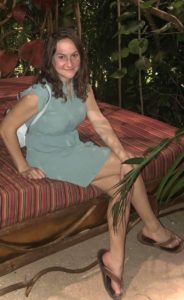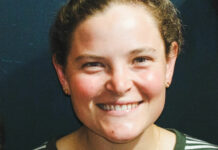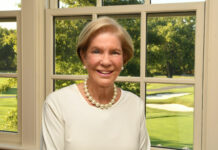
Judith Gale Mont is showing young children the beauty found in nature, and how to transform it into works of art.
Mont is a fine artist and the nature and art director at Chizuk Amuno Congregation’s Goldsmith Early Childhood Center, currently teaching six classes of preschoolers. She is also the vice president of the Molluscan Science Foundation.
A resident of Towson, Mont grew up in Owings Mills, where she attended Chizuk Amuno and Krieger Schechter Day School. She is the eldest of four children, and her parents are an orthopedic surgeon and a former educator. After attending Towson University for early childhood education, Mont studied painting and bio art at the School of Visual Arts in New York.
Mont, who is turning 33 on May 31, is engaged to Joseph Rodman, with the wedding set for August.
How did you come to your current role at Goldsmith?
I was an art teacher in New York, and during the pandemic I ended up moving back home. I decided to connect to my roots with Chizuk Amuno, and I started teaching at the preschool. … I’ve always had a passion for educating children about art and nature. It’s always been in my heart, and they gave me the opportunity to create my own curriculum, which I call “earth art.” It’s been very successful and rewarding for the children and myself. And while doing that, they [made me] the art and nature director, and we started to install a garden fence, and I’m hoping to get the garden going in the community.
How would you describe your earth art curriculum?
It’s focused on inspiring children to create freely, while also exploring their sense of wonder through nature. So we use natural materials we find outside, recycled materials, to create art. We also discuss the seven days of creation and Judaism. We also discuss how we can protect and respect our Earth. So it’s really just inspiring these children to love our Earth and see the beauty in our Earth and how we can protect it, while also creating artwork through that expression.
What kind of art have your students been creating with you?
We’ve been getting the garden ready, so we’ve been painting the garden bed, but instead of just painting them, I’ll cut up sponges and make different … parts of the flowers, so I did the circle, the petals, the stem, and I cut them in different sponges. And instead of just painting it, we learned about the parts of the flower, and then also they formed a flower on the garden bed by painting it. … A lot of my art has to do with the process, so it doesn’t matter how wonderful it looks after. It’s more about the experience and using different types of mediums, and having the children exposed to all different types of mediums.
Is the community garden a part of your earth art curriculum?
So right now it’s separate, but the goal is to connect them … where we’d go out and we’d plant and we’d care for what we plant, and watch it grow and nurture it. … We’re trying to make it a community garden so the whole school can be involved.
What will your students be planting in the garden?
We’re going to do flowers and vegetables this year, and maybe we’ll get brave and move to fruit next year. … We have green beans; basil; parsley; horseradish; morning glories I love to plant because they grow really fat, the children can see them grow tall; sunflowers [and] cucumbers. So right now it’s in my classroom under a grow light, because the garden is not yet finished, but we’re planning to transplant everything once that is done.
Have your students been enjoying your earth art curriculum?
They absolutely love it. They always have so many questions to ask, and the fact that they can just express themselves freely and use different materials I feel is so rewarding for them. It just reduces stress, and I just feel that art and nature reduce stress and help our mental clarity, so I think it’s very important to introduce it at such an early age. … They feel accomplished and proud, and I put their artwork up, and we have little gallery shows, and it’s been very rewarding for them.
Does it feel at all like you’ve come full circle, teaching for a congregation where you once were a student?
It does feel full circle. It is a little funny, I didn’t think I would be back, because I myself am an artist, and I exhibit a lot in New York, but I do like being out of the city and back in nature. It almost feels like I’m back home in a way, because I did go to school there, and I feel like I’m giving back to the community. And it’s really rewarding in the sense to give back.







